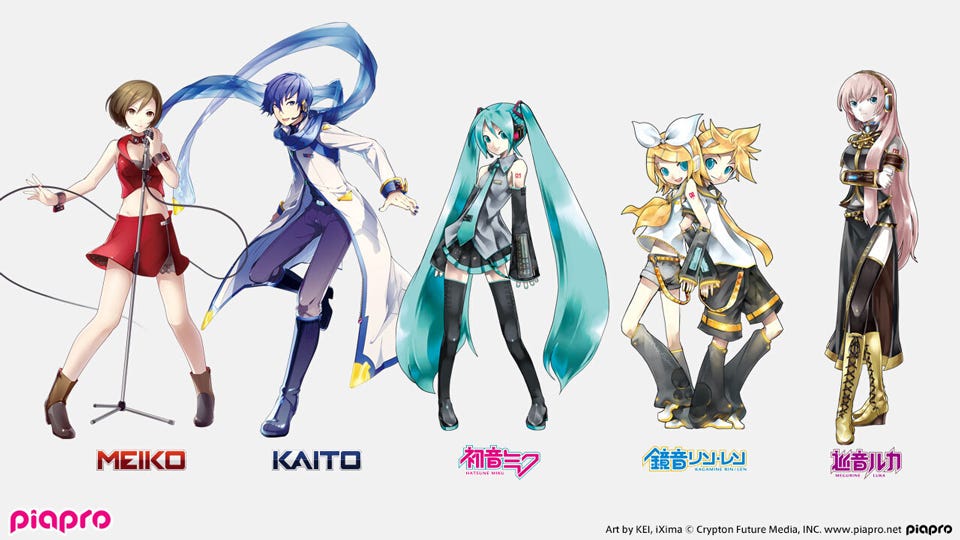INTRODUCTION
To preface, I acknowledge that the term Vocaloid may be unfamiliar to many of you, so I’ll provide a brief introduction to the concept.
Vocaloid is a voice synthesizer program developed by Yamaha Corporation. Essentially, it allows music producers to create vocals for songs by synthesizing lyrics through a voicebank made using a human voice, known as a voice provider. These vocals often have a robotic quality, making it easy to distinguish a Vocaloid voice from a human one. There are countless voicebanks available, but some of the most notable ones include Hatsune Miku, Kagamine Rin and Len, and Kasane Teto.
While Vocaloid refers specifically to the licensed program, there are other voice synthesizer programs such as SynthV, which incorporates AI to make vocals sound more realistic, or UTAU, which is free but rough around the edges. However, many people use "Vocaloid" as a blanket term for all voice synthesizers.
The creators of these songs are known as Producers, and each producer has their unique method of tuning the voicebanks. For example, both DECO*27 and Pinocchio-P frequently use the voicebank Hatsune Miku, yet their styles of tuning sound so distinct that it feels like two completely separate voices. This contrast is particularly evident in their collaboration piece, “(Not) A Devil feat. Hatsune Miku”, where their individual styles take the spotlight.
That’s the basics of Vocaloid, at the very least. Many people refer to Vocaloid as an instrument, which is a simple way to explain it to those unfamiliar with the concept. It’s important to note that Vocaloid isn’t a genre of music but rather a category of songs where voice synthesization is used. Vocaloid songs can span a variety of genres—rock, pop, metal, you name it. Despite the robotic nature of the vocals, they aren’t “AI”; a human meticulously tunes the voicebanks to produce that sound. That said, recent years have seen programs with built-in AI features, such as the previously mentioned SynthV AI, which uses AI to enhance realism in the vocals.
My Infatuation with Vocaloid
In late 2020, deep within the pandemic, I unknowingly stumbled across a music video called “Donut Hole”, produced by Hachi. Initially, I was weirded out—much like most first-time listeners—by the robotic voices. But I stuck around, gradually becoming entranced by the music video and vocals. Before I knew it, I couldn’t take my eyes off the screen. That was my first encounter with Vocaloid.
For a few months after that, I primarily listened to covers of Vocaloid songs performed by human singers, as it was difficult to adjust to the harsh, synthetic vocals of the originals at first.
However, that all changed when I listened to Wowaka’s “Rolling Girl”. I was amazed by his style of tuning, and for the first time, I thoroughly enjoyed the original Vocaloid version. Something clicked in my brain, and from that moment on, I found the original Vocaloid songs from other producers not just tolerable but deeply enjoyable. I’ve been listening to them ever since and haven’t stopped.
One of the main reasons I’ve stuck with Vocaloid for several years now is its subject matter. Many songs explore dark themes such as suicide, depression, and mental health. Japan is notoriously poor when it comes to addressing mental health, so it impacts me deeply to see producers using this medium to freely express and vent their struggles. Vocaloid—and Japanese music in general—often pairs catchy, upbeat melodies with grotesque or dark lyrics. This contrast makes for an extremely captivating and enjoyable experience.
Additionally, I’ve grown to love the community surrounding Vocaloid. There is an incredible wealth of talent in this scene, from artists, animators, and songwriters to fans. Many songs are open to interpretation, and community discussions analyzing the meanings of works—even those over a decade old—are still active and thriving.
My Producer Recommendations
To close out this post, I’ll list some of my favorite producers, highlighting their style, background, and notable works. I limited myself to just a few names to keep this from becoming too long, though there are many more I would’ve loved to include.
Wowaka
Wowaka was one of the greatest producers to ever touch Vocaloid. He exploded onto the scene in 2009 with little to no knowledge of music theory yet consistently achieved high rankings on NicoNico Douga’s charts. He is best known for his high BPM, energetic rock songs, and emotionally intense lyrics. His work paved the way for many producers who would follow in his footsteps.
After releasing his album ‘Unhappy Refrain’ in 2011, Wowaka became disillusioned with the Vocaloid community. He felt as though listeners were recognizing Hatsune Miku, the character, more than himself as the songwriter. This led him to quit Vocaloid and form the band Hitorie, which gained a moderate following.
Two years before he tragically passed away in 2019 due to a heart attack, Wowaka released his first Vocaloid song in 6 years entitled, ‘Unknown Mother Goose’, a powerful song voicing his concerns built up throughout his career. The song has amassed sixty million views on the official Hitorie Youtube channel. Wowaka was admired so much that in the same year of his death, during the largest annual Vocaloid concert, Magical Mirai, a tribute was held everyday of the concert, mourning his passing. Wowaka will forever be remembered as one of the most impactful and talented producers in Vocaloid history and my personal favourite.
Notable Works:
Hachi
Hachi was an early Vocaloid producer active mainly from 2009 to 2011. His music is often described as grotesque yet captivating, with surreal and vivid music videos that tell ambiguous, open-ended stories. Hachi’s sound is marked by unconventional rhythms, chaotic tempos, and a unique embrace of the robotic quality of Vocaloids.
Today, Hachi is better known as Kenshi Yonezu, Japan’s most popular artist, breaking several records in the Japanese music industry with his own vocals. After releasing his first solo album, “Diorama”, in 2013, Hachi rarely returned to Vocaloid, except when he produced a vocaloid single “Dune” in 2017.
Notable Works:
Giga
Giga is renowned for his high-energy, polished tracks that blend genres like EDM, dubstep, and J-Pop. His music is defined by its danceable rhythms, modern production, and electrifying sound. Giga’s tracks consistently feature high BPMs and a refined, energetic feel that makes them stand out in the Vocaloid scene.
Giga frequently collaborates with other artists, most notably Reol and Ado, the latter of whom has exploded onto the Japanese pop scene in recent years.
Notable Works:
DECO*27
One of the most prominent and recognizable producers, DECO*27 has been a major figure in the Vocaloid sphere since his debut in 2008. His music blends J-Pop, rock, and electropop, pairing catchy, energetic melodies with deeply emotional lyrics.
DECO*27’s songs often revolve around themes of love, relationships, heartbreak, and inner struggles. His ability to create memorable hooks and his instantly recognizable tuning style make him a standout figure in Vocaloid. He is one of the most influential producers, with many of his works amassing tens of millions of views.
Notable Works:
Closing
I thoroughly enjoyed writing this post, as it gave me a chance to rant about my favorite music. Let me know what you think about this kind of post, as it’s a departure from the first two I’ve made on this account. Did I successfully introduce you to the wonderful world of Vocaloid? I’d love to hear your thoughts.
See you next time!









